Early autumn is a wondrous time. Gardens begin to sparkle as the sharp crystal-clear light enhances rich pinks, subtle blues, golden yellows and mahogany reds and the colours seem to intensify as the season wears on, and the nights draw in. Fading flowers, many being strong-stemmed enough to stand through the winter months will also often pull in a flock of grateful finches to gorge on their seed heads, and Asters are one of these plants. Asters are worth their weight in gold in the garden often continue to flower well into autumn, and if you add some grasses to sway and move in the breeze, your garden will please the eye for months.
Which Aster?
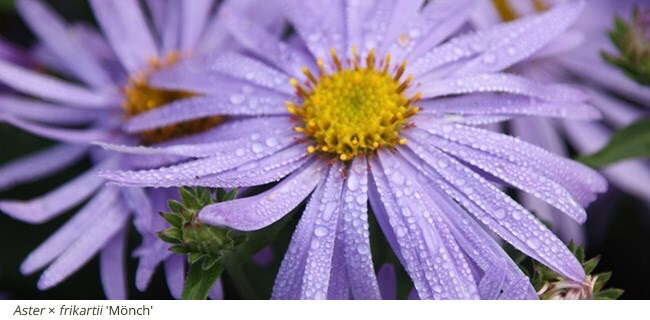
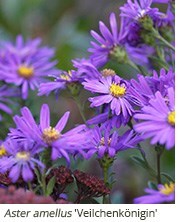 Heavy morning dews keep everything as fresh as a daisy, but finding the right daisy in a sea of varieties is the key to success. Michaelmas daisies for instance, grow in North America, Asia and Europe in a variety of locations. Some are dry, some alpine and some positively marshy. For many years the most popular Michaelmas daisies, or asters, were selected forms of the moisture-loving New York asters (A. novi-belgii), which are used to boggy conditions. They struggled to perform well in many gardens, developing unsightly mildew, and this gave the whole tribe a bad name. Heavy morning dews keep everything as fresh as a daisy, but finding the right daisy in a sea of varieties is the key to success. Michaelmas daisies for instance, grow in North America, Asia and Europe in a variety of locations. Some are dry, some alpine and some positively marshy. For many years the most popular Michaelmas daisies, or asters, were selected forms of the moisture-loving New York asters (A. novi-belgii), which are used to boggy conditions. They struggled to perform well in many gardens, developing unsightly mildew, and this gave the whole tribe a bad name.
Simply the Best
However there are lots of asters that are undemanding and reliably perennial, even in dry gardens. These are the ones to grow. The finest of all is Aster x frikartii ‘Monch’ and this will flower from July until late September, producing large lavender-lashed flowers with neat yellow middles. The flowers are enhanced by good, dark-green foliage, which never gets diseased, and the stems are strong enough not to need staking, despite the fact that this plant curtsies a little. Give it a front of border position for it always looks pristine. 'Mönch’, named after a Swiss mountain, was one of a series bred in 1921 by the Swiss nurseryman Frikart. He used an alpine Himalayan species (A. thomsonii) and a drought-tolerant Italian aster (A. amellus). This very difficult cross, only successfully made by Frikart, Alan Bloom and Wolley-Dod, produced a bombproof handsome aster that will thrive in any garden. A.amellus 'Veilchenkönigin’ is one of these Italian asters worthy of note with a compact habit, good resistance to mildew and an RHS Award of Merit (AGM). This is an excellent older variety with yellow-centred deep violet/purple flowers, often 5cm across, smothering the plant from August to October.
Quite different in form, but equally robust, is ‘Little Carlow’ a bushy aster with fine foliage and sprays of lavender-blue flowers that appear from buds stippled in red. In September light this aster glows with hundreds of tiny flowers on a rounded bush. It’s an excellent plant set back a little, on the corner of a border, or another prominent position where it assumes a rounded shape. Again it’s self-supporting.
Forms of the September-flowering New England Aster, Symphyotrichum novai-angliae, have stiff, upright stems topped with clusters of nectar-rich flowers that pull in the butterflies. ‘Purple Dome’ has yellow-centred, deep violet-purple flowers with a compact domed habit, so no need for staking like some of the taller varieties. Long flowering from late August to October this fetching plant looks splendid in the autumn garden with the dusky pink to pigeon-breast grey Hylotelephium ‘Matrona’, or one of the Pennisetums such as P. villosum with the fluffy flowers swaying in the wind softening the planting. For a little more height P. alopecuroides 'Hameln', is a popular hardy grass producing brown, furry, caterpillar-like flower spikes, commonly called the ‘fountain grass’ because of the masses of furry squirrel tails it produces.
Coneflowers and Sneezeweeds
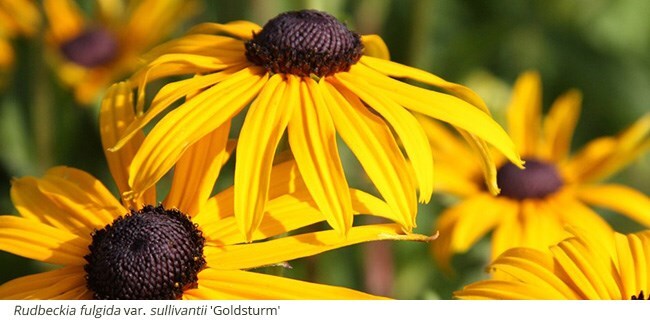
A perfect next door neighbour for the lavender flowers of Aster x frikartii 'Mönch’ is the crisp yellow and brown coneflower or rudbeckia. The neatest and most consistent are Rudbeckia fulgida var. deamii (Deam’s coneflower) and Rudbeckia fulgida var. sullivantii 'Goldsturm'. The latter, a mouthful of a name, is usually seed-raised so may be variable. Flower colour and size are slightly different. If a smaller, neater orange-yellow is preferred opt for Deam’s coneflower (R. fulgida var. deamii). If you want larger-rayed, less-formal, yellow flowers opt for ‘Goldsturm’, This was first spotted at a botanic garden in Czechoslovakia in 1937 by Heinrich Hagemman, an employee of the famous German nurseryman Karl Foerster. Both rudbeckias deserve a place in any garden, but ‘Goldsturm’ is better in naturalistic planting schemes, whilst the crisper Deam’s coneflower looks sprucer and sharper, like James Bond in a dinner-jacket.
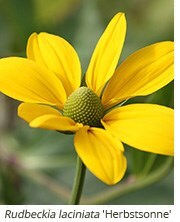 Taller by far are the leggy forms of Rudbeckia laciniata, which can reach man height or more. ‘Herbstsonne’ a simple single that has almost apple-green cones, a superb plant staying in clumps without running into other things, as so many tall yellow daisies are wont to do, creating interesting winter silhouettes.This is a perfect foil for tall moor grasses such as ‘Heidebraut’, for its all-brown spikelets that gently bend and sway, or the architectural Calamagrostis × acutiflora 'Karl Foerster’, a feather reed grass with a strong upright habit adding definition to the border, which is also great for screening. As autumn progresses the flowers and stems fade to a golden buff colour. Leave these through the winter as structure in your borders cutting them back early in spring. Finally find room for the Korean feather grass, Calamagrostis brachytricha, because its glossy feathers are a soft mauve in early autumn and this flatters every aster going. Taller by far are the leggy forms of Rudbeckia laciniata, which can reach man height or more. ‘Herbstsonne’ a simple single that has almost apple-green cones, a superb plant staying in clumps without running into other things, as so many tall yellow daisies are wont to do, creating interesting winter silhouettes.This is a perfect foil for tall moor grasses such as ‘Heidebraut’, for its all-brown spikelets that gently bend and sway, or the architectural Calamagrostis × acutiflora 'Karl Foerster’, a feather reed grass with a strong upright habit adding definition to the border, which is also great for screening. As autumn progresses the flowers and stems fade to a golden buff colour. Leave these through the winter as structure in your borders cutting them back early in spring. Finally find room for the Korean feather grass, Calamagrostis brachytricha, because its glossy feathers are a soft mauve in early autumn and this flatters every aster going.
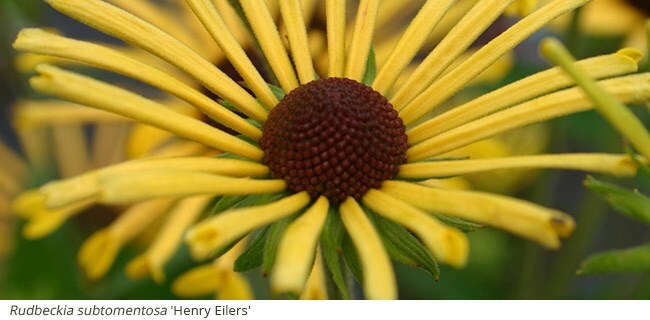
Metre high yellow daisies are also useful and the black-stemmed wiry profile of Heliopsis helianthoides var. scabra ‘Summer Nights’ is a must. Its single daisies float above the planting on their sultry stems, like small spinning plates. The quilled petals of Rudbeckia subtomentosa ‘Henry Eilers’ are another great addition. This was spotted in a remnant of American prairie in southern Illinois, right by a railway, and named for the retired nurseryman who found it. The leaves smell of vanilla when crushed.
Add a Touch of Warm Red

Ignite those golden yellows with a touch of rufous-red by growing a helenium or two. ‘Rauchtopas’, meaning smoky topaz, has petals swept up like the rim of a sombrero, showing warm orange-red on the undersides. The warm mahogany ‘Moerheim Beauty’, bred in the 1930s at Ruys’ Royal Moerheim Nurseries in The Netherlands, has the flouncing skirts of a flamenco dancer in full flow. This will bloom late, right up until October if happy, reaching a metre in good soil, and it’s still the best of the bunch. However if compact shorter plants are better for you, there is a newer helenium growing to about 50cm on upright stems that also flowers later. H. autumnale 'Salsa' has the vibrant fiery reddy and orange blooms to set your border alight well into the autumn, plant in drifts for maximum effect.
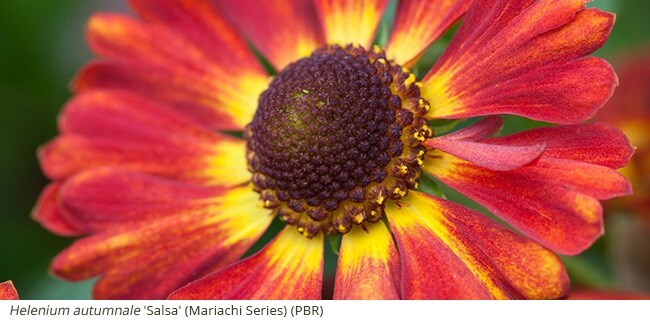
Uniting Your Planting
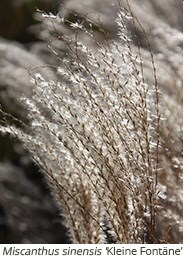 Finally pull everything together by threading graceful forms of tall Miscanthus sinensis through your planting, for their plumes of flower last into winter. Classic varieties include ‘Malepartus’, great for larger areas and grown for its purplish awns, which turn cotton-wool white and fluffy in winter, or ‘Gracillimus’ - it may be shy to flower, but it is gorgeous for its foliage. ‘Kleine Silberspinne’ is shorter with rose-pink awns that age to silver and ‘Kleine Fontäne’ has floppier paler pink awns that are held well above the foliage. For smaller areas ‘Red Cloud’ is definitely worth mentioning, a newer introduction that has the benefit of being compact but no less stunning with eye-catching red flowers above arching fresh green foliage, wonderful planted with the smaller Rudbeckias and Heleniums. All these will all shine and shimmy, particularly at sunset. |












